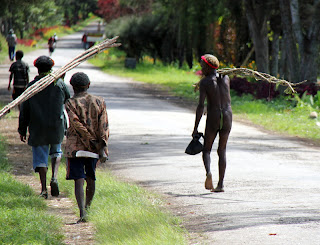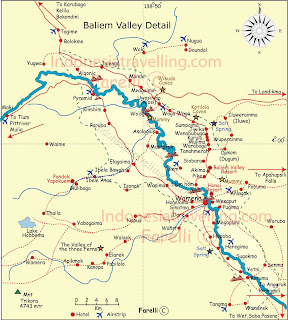We start the day around 9am with procuring lunch for the
guide and driver from the restaurant across the street and large bottles of water
for each of us. We tried to have the hotel fix us 4 hard boiled eggs and 4
peanut butter and jelly sandwiches and we got 4 sandwiches with sunny side up
eggs, lettuce and ketchup, with peanut butter in a messy glob on the side, so
after that first day we made our own lunches. We drove northwest to Wosi to see
the local cave, and afishing pond especially known for its gold fish (a
favorite fish to eat here). The location
of the fishing pond also had overnight huts for trekkers so we checked those
out. The cost was $25 per person per night and they had a place for a wood fire
and one had some cold running water.
There were basic toilet facilities available as well. We went inside a Dani house, called ”honai”,
which are circular huts with a thatched roof.
The lower flower is built a foot above the ground and the sleeping area
is about 4 feet above that. The sleeping area is entered through a small square
hole in the low ceiling to climb to the “loft”. Both floors are carpeted with
grass straw. In the center of the ground
floor is a hearth, which is delineated with four upright poles in each corner.
The smoke of the fire must escape through the small doorway onto the courtyard
or under the hanging fringe of the roof.
David then went a short distance into the cave with Mac and
returned after going in about 100 yards – normal cave with stalagmites, etc.,
but they had not found the end yet. We
had lunch and then came back to Wamena and went to the local grocery store
which we were happy to see had peanut butter, nutella and sweetener. We took our laundry across the road to a
laundry service and were gagging at the $10 price. Everything in Wamena is basically flown in –
including cars, gasoline, asphalt for roads and all building materials with the
exception of wood, so the expense base is very high. Fresh vegetables, especially sweet potatoes
and tarot, and a poor quality of rice are grown here in the valley. Pigs, cows,
goats and chickens are raised here, with pigs being the most dominant. We
trekked off the road to several other villages where they were supposed to have
mummies, but all of them were “closed” to tourists with the mummies hidden
indoors, and villages mostly deserted when we arrived. So we returned to our
hotel by 2:30, quite an early close for the day’s tour.
We are eating all our meals here in the hotel to try and
avoid any stomach issues. We also are
taking our Malarone anti-malaria pills every night after dinner.
The next morning we headed south. We had discussed with Mac
that we wanted to bring a gift to either a Dani village or a school that we
would visit, and explained that in Burma we had carried dried fish, chilies,
seeds and such items up to the different villages we visited, and that in
Thailand we had given books to a school. We gave him some time to think about
what would be best, and he decided on paper notebooks, pencils and other items
for an elementary school. So we stopped
on our way out of town at the biggest store and purchased some puzzles, some
3-D puzzles, packs of crayons, packs of notebooks and packs of pencils and
erasers along with some sea life display items for display on the class room
wall. Mac also insisted we buy a Statue of Liberty so the children would be
told about America.

We drove through rolling hills as the valley walls began to
narrow. We came to an area that was the
“landslide” area. Basically water flows,
sometimes very fiercely during the rains and keeps washing down large rocks and
sand, washing out the road. While in
this landslide area we drove down to the river where there is a hanging “yellow
bridge”, where we parked and unloaded our gifts. We then walked across the bridge and down a
path till we came to an elementary school with the children all out in the
field for recess. We met the teachers
and head of the school and gave them our gifts, for which they seemed surprised
and pleased. We then had our pictures
taken with the children and headed down the path further to a lake. The path got more treacherous, muddy and
steep so being the risk-adverse people we are because we have a wedding coming
up we elected to stop and turn around. We believe this village was called
Maima.
 |
| Moving carefully holds up the que |
We then drove further south and arrived at a stream where we
ate our lunch watching the women washing their vegetables in the stream. Moving
on from there we stopped at the point where you saw the Baliem River. At this
area, later known as Minimo, is where the first missionaries landed on April
20, 1954 by amphibian aircraft on the river. They were a group of Americans and
a converted family from the Kapaukus tribe that made up the initial “Baliem
Project”. The plane basically landed and unloaded tents, tinned food etc and
took off back to Sentani. The valley had
actually been discovered by the American Natural History Museum team lead by Richard
Archibald in 1938, when he saw the valley as he landed his seaplane in a much
higher lake, Lake Habbema at 3,400 meters. Archibald had been on an expedition
around the world along the equator looking for new bird, plant, and animal
species.
 On our way back, we stopped at the “mission museum” and saw
a couple of monuments commemorating the missionaries’ landing. On the large
carved stone wall on the lower left hand side a sea plane was carved. We had
had various discussions with Mac on missionary activities, and were lead to
believe they built no schools, hospitals etc., but only worked on converting
Dani to Christianity, their success in this at least being evidenced by the
many churches. We had a hard time
believing they did not contribute more, so at the end of the day we asked to be
taken to the mission compound so that we could talk with some of the
missionaries.
We left our business card
with our Indonesian phone number and a note that we wanted to hear of their
activities here in the Baliem Valley.
Within 20 minutes we had a call and within the hour we were meeting and
seeing the MAF (Mission Aviation Fellowship) operation and meeting a couple of
the staff working there, and then also across the street at the NRC
(Netherlands Reformed Church), where they have many community training
programs. We asked where the NRC church
was, as this would be the equivalent of the church for which David’s parents and
his grandfather served. Our driver was
given directions so we went there and then also to see the new school, where we
met the Dutch headmaster. He also pointed out the new theology college that the
NRC is building.
On our way back, we stopped at the “mission museum” and saw
a couple of monuments commemorating the missionaries’ landing. On the large
carved stone wall on the lower left hand side a sea plane was carved. We had
had various discussions with Mac on missionary activities, and were lead to
believe they built no schools, hospitals etc., but only worked on converting
Dani to Christianity, their success in this at least being evidenced by the
many churches. We had a hard time
believing they did not contribute more, so at the end of the day we asked to be
taken to the mission compound so that we could talk with some of the
missionaries.
We left our business card
with our Indonesian phone number and a note that we wanted to hear of their
activities here in the Baliem Valley.
Within 20 minutes we had a call and within the hour we were meeting and
seeing the MAF (Mission Aviation Fellowship) operation and meeting a couple of
the staff working there, and then also across the street at the NRC
(Netherlands Reformed Church), where they have many community training
programs. We asked where the NRC church
was, as this would be the equivalent of the church for which David’s parents and
his grandfather served. Our driver was
given directions so we went there and then also to see the new school, where we
met the Dutch headmaster. He also pointed out the new theology college that the
NRC is building.
 |
| Kevin -watch out for that propeller! |
We went back to the hotel and around 6pm Kevin and Beth
Lynne came knocking at the door to invite us to their home for dinner next
night. We had met Kevin, an American pilot, at the MAF hanger working on his
plane. He had said he would stop by to loan us the book Cannibal Valley by
Russell T. Hitt, about the early missionary activity in Balien Valley. Kevin
was raised in Papua as his father had also served with the MAF flying food,
missionaries, emergency evacuations, etc. to the remote airstrips that are the
only way to move around in Papua’s interior.
We are excited to have an opportunity to hear of his stories growing up
and their work here in the valley and surrounding territory.
Other reading material we have on this area is Under the
Mountain Wall by Peter Matthiessen. The
missionary pioneers to Papua had a pretty challenging situation to deal with.























































